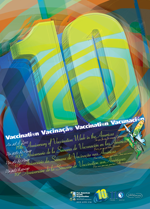 The complex health challenges facing the Americas at the start of the new millennium, coupled with the changing landscape of international development cooperation, led to a broad-reaching review of PAHO/WHO’s technical cooperation programs, its organizational and managerial models, and its relations with Member States and other stakeholders.
The complex health challenges facing the Americas at the start of the new millennium, coupled with the changing landscape of international development cooperation, led to a broad-reaching review of PAHO/WHO’s technical cooperation programs, its organizational and managerial models, and its relations with Member States and other stakeholders.
Part of this process was led by a special Working Group on PAHO in the 21st Century, made up of Argentina, Barbados, Costa Rica, Cuba, and Peru, with the collaboration of Canada, Guatemala, Haiti, and the United States. Following a process of consultations with other Member States, the group issued a report analyzing the challenges and opportunities facing the Organization and making recommendations for its technical cooperation programs and internal reform.
The group’s recommendations were incorporated into a major reorganization effort that had already been launched by PAHO’s Executive Management in 2003. The combined processes produced changes in PAHO’s program structure, resource allocation, human resources management, and interactions with Member States and other partners.
 The Report of the Working Group on PAHO in the 21st Century reiterated three overarching mandates bestowed on PAHO/WHO by its Member States at the beginning of the 2000s: (a) to support countries’ progress on the health-related Millennium Development Goals (MDGs) by incorporating them into its technical cooperation programs, policies, and operations and by helping countries integrate them into their national health policies; (b) to support countries in redoubling their efforts to guarantee expanded social protection in health; and (c) to ensure that all the Organization’s technical programs are grounded in the principles of primary health care.
The Report of the Working Group on PAHO in the 21st Century reiterated three overarching mandates bestowed on PAHO/WHO by its Member States at the beginning of the 2000s: (a) to support countries’ progress on the health-related Millennium Development Goals (MDGs) by incorporating them into its technical cooperation programs, policies, and operations and by helping countries integrate them into their national health policies; (b) to support countries in redoubling their efforts to guarantee expanded social protection in health; and (c) to ensure that all the Organization’s technical programs are grounded in the principles of primary health care.
In addition, the working group identified a number of key functions for PAHO/WHO in the changing landscape of international health cooperation. These included (a) providing leadership, coordination, and technical orientation for the growing number of health actors in the Region; (b) mobilizing resources; (c) promoting partnerships and networks for health; (d) facilitating the exchange of knowledge, technology, and technical capability; (e) developing systems and mechanisms for accountability and transparency; and (f) working to ensure consistency between strategies and actions at the national, regional, and global levels.
This chapter presents highlights of the Organization’s technical cooperation in these areas, with emphasis on the past five years. Chapter III details the institutional changes carried out in response to the PAHO in the 21st Century report and other mandates from the Member States.
The Achievement of the MDGs and the Renewal of Primary Health Care
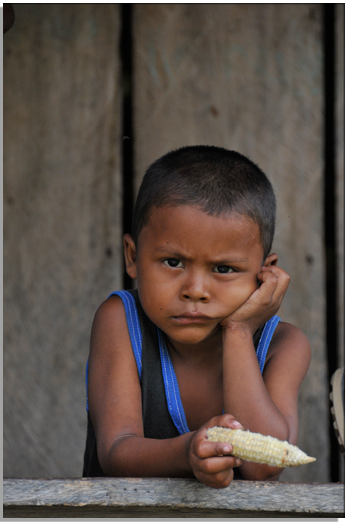 As noted in Chapter I, the Region of the Americas advanced significantly toward the health-related and other MDGs during the first decade of the 2000s, although progress varied across countries, and in all countries there were communities and groups that did not share fully in the resulting benefits.
As noted in Chapter I, the Region of the Americas advanced significantly toward the health-related and other MDGs during the first decade of the 2000s, although progress varied across countries, and in all countries there were communities and groups that did not share fully in the resulting benefits.
PAHO/WHO technical cooperation contributed to MDG progress through both ongoing programs and initiatives launched specifically to advance the MDGs. These included programs and projects to reduce child and maternal mortality, improve nutrition, fight HIV and other infectious diseases, promote access to safe drinking water and sanitation, strengthen health systems, and expand social protection in health.
To advance the MDGs at the local level, PAHO/WHO created the Faces, Voices, and Places initiative, which promotes an integrated and participatory approach to health and development in vulnerable communities. The initiative works through multisectoral and inter-agency partnerships to provide technical cooperation that empowers communities to address the social determinants of health. By 2012, the initiative had grown to include more than 50 communities in 23 countries and four transnational territories.
This and other PAHO/WHO technical cooperation efforts in support of the health-related MDGs are presented in detail in the 2011 Annual Report of the Director, Health and the Millennium Development Goals: From Commitment to Action (CD51/3 [2011]).
One of the most important regional health efforts of the decade, one that contributed significantly to advancing the MDG agenda, was the process of “Primary Health Care Renewal,” launched in 2003 on the 25th anniversary of the 1978 International Conference on Primary Health Care (“Alma Ata”). At the request of Member States, PASB organized a series of activities to commemorate the legacy of Alma Ata and its call for “Health for All.” During consultations held at the regional, subregional, and country levels, Member States examined experiences with the adoption of the primary health care (PHC) strategy over the previous 25 years and analyzed their relevance for making current health systems more efficient, effective, and equitable. These activities led to the publication in 2007 of Renewing Primary Health Care in the Americas, a PAHO position paper that laid out strategic lines of action for developing and strengthening health systems based on primary health care.
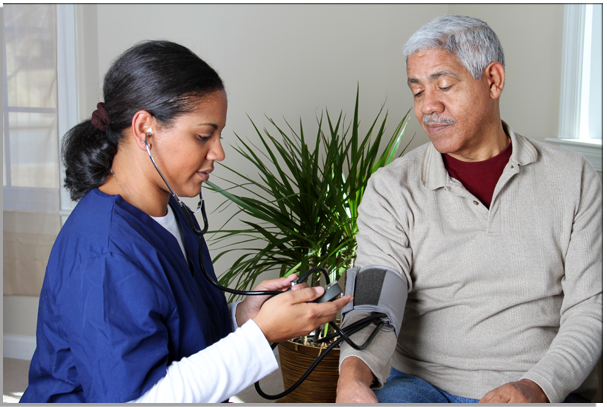 This renewed vision of PHC was endorsed by the 2007 international conference “Buenos Aires 30/15: From Alma Ata to the Millennium Declaration,” was incorporated into the Health Agenda for the Americas 2008-2017 and was reinforced at the global level in the 2008 World Health Report Primary Health Care, Now More than Ever.
This renewed vision of PHC was endorsed by the 2007 international conference “Buenos Aires 30/15: From Alma Ata to the Millennium Declaration,” was incorporated into the Health Agenda for the Americas 2008-2017 and was reinforced at the global level in the 2008 World Health Report Primary Health Care, Now More than Ever.
The PHC strategy guided PAHO/WHO’s work in the area of health systems strengthening for much of the decade. The renamed Area of Health Systems Based on Primary Health Care (HSS), together with other PAHO/WHO areas, provided technical cooperation aimed at making health systems more efficient, equitable, inclusive, and effective. Key programmatic areas included integrated health services delivery networks (IHSDN), human resources for health, quality and acceptability of care, access to medicines and health technologies, gender equality and multiculturality, policymaking, and research. Examples of this work included:
- (a) National consultations organized in 10 countries—Argentina, Belize, Brazil, Chile, Cuba, Ecuador, Mexico, Paraguay, Trinidad and Tobago, and Uruguay—on IHSDN as a strategy to increase efficiency and quality in fragmented health systems. Participants included representatives of ministries of health, social security institutes, private insurers and health providers, academia, civil society organizations, and professional associations.
- (b) Efforts to strengthen the organization and management of emergency medical services (EMS) through reviews of existing legislation, publication of a manual on triage in emergency rooms, and the development of a regional situation analysis on EMS with a focus on pre-hospital care. To date, case studies have been completed in 14 countries: Bolivia, Chile, Colombia, Costa Rica, the Dominican Republic, Ecuador, Honduras, Guatemala, Nicaragua, Panama, Paraguay, Peru, Uruguay, and Venezuela.
- (c) Support for the development, revision, and implementation of pharmaceutical policies in 12 countries: Barbados, Belize, Colombia, Ecuador, El Salvador, Haiti, Nicaragua, Panama, Paraguay, St. Lucia, Suriname, and Uruguay.
- (d) Strengthening of national drug regulatory authorities (NRAs) through the Pan American Network for Drug Regulatory Harmonization (PANDRH), created in partnership with NRAs throughout the Region to advance pharmaceutical regulatory harmonization.
- (e) Support for national evaluations of radiotherapy services in 11 countries—Bahamas, Costa Rica, the Dominican Republic, El Salvador, Guyana, Honduras, Nicaragua, Panama, Paraguay, Suriname, Trinidad and Tobago—and of imaging services in Guyana, Suriname, and Trinidad and Tobago.
- (f) Evaluation and improvement plans for radiological safety regulation in Argentina, Colombia, Costa Rica, Honduras, Nicaragua, Panama, and Paraguay, and a plan of action for member countries of CARICOM.
- (g) Support for national evaluations of mental health systems in 32 countries of Latin America and the Caribbean using the WHO Assessment Instrument for Mental Health Systems (WHO-AIMS), to provide evidence for national health planning.
- (h) Collaboration in most Latin American and Caribbean countries in the development and dissemination of national policies on research for health.
- (i) Development of detailed collaboration plans for 10 countries—Bolivia, Colombia, El Salvador, Guatemala, Guyana, Honduras, Nicaragua, Paraguay, Peru, and Suriname—to incorporate gender equality into the health sector.
- (j) Support for six countries—Bolivia, Chile, Colombia, Ecuador, Peru, and Venezuela—in creating national commissions to address the special health needs of Afro descendants.
- (k) Impetus for the establishment of a Caribbean working group on access of key groups—especially sex workers, men who have sex with men, and transgender persons—to quality services for HIV prevention, treatment, and care.
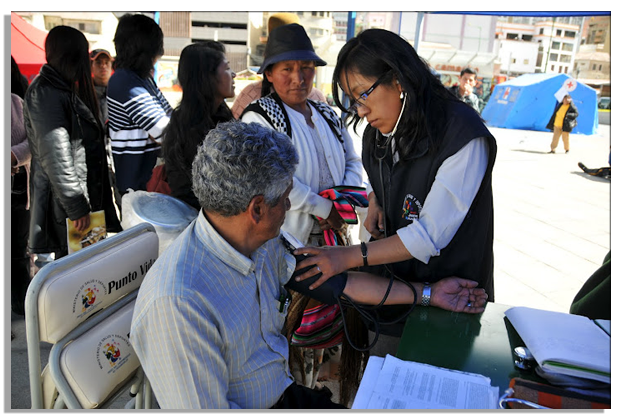 In addition to these efforts aimed at strengthening health systems, PAHO/WHO also carried out a number of initiatives to strengthen the PHC approach itself. These included a partnership with New York University to collect baseline data for monitoring PHC progress in the countries of Latin America and the Caribbean and a partnership with Johns Hopkins University to develop an analytical framework and methodology for measuring health system performance from a PHC perspective. The 2009 Annual Report of the Director, Advancing toward “Health for All”: Progress in Primary Health Care in the Americas, provides further details on PAHO/WHO’s efforts to advance PHC.
In addition to these efforts aimed at strengthening health systems, PAHO/WHO also carried out a number of initiatives to strengthen the PHC approach itself. These included a partnership with New York University to collect baseline data for monitoring PHC progress in the countries of Latin America and the Caribbean and a partnership with Johns Hopkins University to develop an analytical framework and methodology for measuring health system performance from a PHC perspective. The 2009 Annual Report of the Director, Advancing toward “Health for All”: Progress in Primary Health Care in the Americas, provides further details on PAHO/WHO’s efforts to advance PHC. As noted in Chapter I, one of the most significant health achievements of the Region during the first decade of the 2000s was progress toward universal access to health care, a central goal of the PHC approach. Expanding access to health care has required countries to seek innovative approaches to financing and managing their health systems in order to increase efficiency and sustainability. Argentina, Bolivia, and Colombia are among a number of countries that have improved management and training of human resources to ensure that the distribution, composition, and skills of the health care workforce are aligned with priority health needs. Other countries have increased sustainability and efficiency through decentralization, such as in Brazil’s Unified Health System, which is partly managed and funded by states and municipal governments. Other countries, such as Mexico, have focused on the development of IHSDN to improve both the efficiency and the quality of health services. PAHO/WHO has supported and promoted these approaches at both the national and regional levels.
The Organization also has worked closely with ministries of health to improve their capacity to produce and analyze information for health planning, economics, and financing of health systems and to improve both efficiency and equity in the allocation and use of available resources.
Using a methodology developed by PAHO/WHO, seven countries—Brazil, Canada, Chile, Colombia, Jamaica, Mexico, and Peru—completed a first set of studies on the evolution over the past 10-15 years of equality in the utilization of health services. The results showed reductions in inequality in four of the countries, no change in two, and increased inequality in one.
An initiative with the Andean Commission of Economics and Health (CASE) and the U.N. Economic Commission for Latin America and the Caribbean (ECLAC) seeks to harmonize health expenditure data in the Andean countries. PAHO/WHO has also begun developing a new common framework for analyzing the economic impact of the growing burden of noncommunicable diseases in the Region to support the formulation of policies within a framework of multisectoral action.
PAHO/WHO’s ProVac initiative, supported by the Bill & Melinda Gates Foundation, helped countries gather and analyze evidence for decision-making about the introduction of new vaccines and also provided guidance in planning the effective and sustainable incorporation of new vaccines into their national immunization plans.
In contrast to earlier decades, when the Region’s lower-income countries lagged significantly behind the United States and Canada in introducing newly available vaccines, 24 Latin American and Caribbean countries and territories introduced the new pneumococcal conjugated vaccine, and 16 introduced the rotavirus vaccine between 2002 and 2012. A number of countries were also successful in increasing uptake of seasonal influenza vaccine, and many, with PAHO technical and procurement support through the PAHO Revolving Fund, successfully implemented the 2009 pandemic H1N1 vaccine, despite considerable regulatory, logistical, and public relations challenges.
10 Years of Vaccination Week in the Americas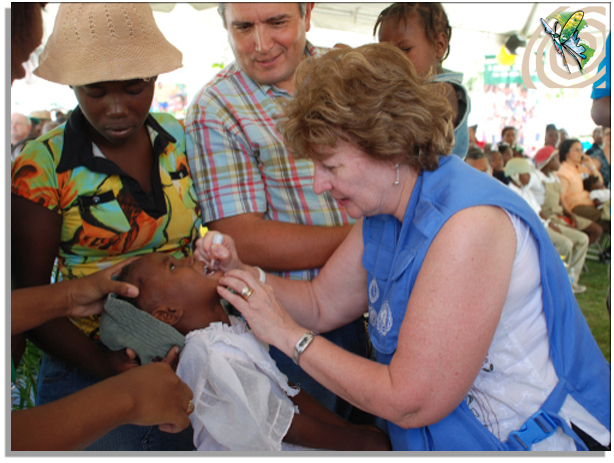
A major regional health milestone was the celebration in 2012 of the 10th anniversary of Vaccination Week in the Americas (VWA), the Region’s largest Pan American health initiative. Including 44 million men, women, and children targeted in 45 countries and territories in 2012, VWA |
PAHO’s Revolving Fund and Strategic Fund played a key role in efforts to improve efficiency in health systems, by procuring vaccines, medicines, and other public health supplies at lower prices through bulk purchases but also by linking their acquisition to technical processes in planning and programming. Annual expenditures on behalf of PAHO Member States by the Revolving Fund increased from US$ 105.3 million in 2000 to US$ 505.3 million in 2011 and for the Strategic Fund from US$ 3.5 million in 2004 (its first year of full operations) to US$ 49.7 million in 2011. With over 24 countries now participating in the Strategic Fund, it has been used by Member States to triple the amount of medicines available for Chagas treatment since 2008, while helping to lower prices for medicines to treat HIV/AIDS, tuberculosis, and malaria.
Leaders in International Health Program
As part of efforts to strengthen human resources for health, PAHO/WHO in 2008 launched a new, decentralized version of its training program for professionals in international health, originally established in 1985. The new “Edmundo Granda Ugalde” Leaders in International Health Program (LIHP) targets mid- to high-level managers and directors in decision-making positions in ministries of health, development, finance, foreign affairs, and others, as well as from academia, NGOs, PAHO/WHO country offices, and other international agencies. Each nine-month session includes a series of problem-based virtual learning experiences using the Virtual Campus for Public Health. In addition, participants become members of inter-sectoral country teams that develop and implement projects based on country needs and priorities, in cooperation with PAHO/WHO country offices, national authorities, and other national and international partners. Since its launch in 2008, more than 200 professionals from 32 countries have participated in the redesigned program, contributing to more than 90 country projects and, in some cases, to the transformation of PAHO/WHO technical cooperation models. |
Combating Chronic Diseases
 In the early 2000s, chronic noncommunicable diseases (NCDs) emerged as the leading cause of death and illness in nearly all PAHO/WHO member countries. The Organization supported efforts to confront the epidemic at the regional, subregional, and country levels through advocacy and policymaking, surveillance, health promotion and prevention, and integrated disease management.
In the early 2000s, chronic noncommunicable diseases (NCDs) emerged as the leading cause of death and illness in nearly all PAHO/WHO member countries. The Organization supported efforts to confront the epidemic at the regional, subregional, and country levels through advocacy and policymaking, surveillance, health promotion and prevention, and integrated disease management.
Guiding this work were the Regional Strategy and Plan of Action on an Integrated Approach to the Prevention and Control of Chronic Diseases, including Diet, Physical Activity, and Health, as well as specific strategies on diabetes and obesity, cervical cancer, and nutrition in development. The countries made significant progress in implementing these strategies and other initiatives targeting NCDs throughout the decade.
In Argentina, the Organization supported the creation of a new Department of Health Promotion, Prevention, and Control of NCDs; a new National Cancer Institute; a new program for prevention and control of cervical cancer; and improvements in information systems related to cancer. It also supported initiatives to reduce dietary salt, increase fruit and vegetable consumption, eliminate trans-fats from industrially processed foods, and promote tobacco control legislation.
In Aruba, PAHO/WHO partnered with the Ministry of Health to organize the first and second Pan American Conference on Obesity (PACO) in 2011 and 2012. The conferences brought together ministers of health, education, agriculture, development, transportation, and others, as well as representatives of local governments and civil society to examine the causes of obesity and to promote multisectoral action to prevent and address the problem.
 In Belize, PAHO/WHO partnered with the Food and Agriculture Organization (FAO), the Institute of Nutrition of Central America and Panama (INCAP), and the Caribbean Food and Nutrition Institute (CFNI) to support the development of food-based dietary guidelines known as the Belize Food Basket. The approach converts scientific information on nutritional requirements and food composition into easily understandable guidelines to encourage healthy food choices and promote prevention. The new Food Basket was launched in 2012 by the ministries of health, education, and agriculture.
In Belize, PAHO/WHO partnered with the Food and Agriculture Organization (FAO), the Institute of Nutrition of Central America and Panama (INCAP), and the Caribbean Food and Nutrition Institute (CFNI) to support the development of food-based dietary guidelines known as the Belize Food Basket. The approach converts scientific information on nutritional requirements and food composition into easily understandable guidelines to encourage healthy food choices and promote prevention. The new Food Basket was launched in 2012 by the ministries of health, education, and agriculture.
In Brazil, the Organization supported efforts by the National Tobacco Control Program to implement provisions of the Framework Convention on Tobacco Control (FCTC). These included the approval of a law on smoke-free public spaces, new restrictions on tobacco advertising, requirements for health warnings on packages, and new taxes on tobacco products. The Bloomberg Family Foundation supported these efforts as well as a similar one in Mexico as part of the Bloomberg Global Initiative.
In Colombia, PAHO/WHO partnered with the Ministry of Health to strengthen implementation of the country’s tobacco control laws, to establish norms for healthy meals in schools, and for a pilot project to transform the ministry as well as PAHO/WHO’s country office into “healthy workplaces.”
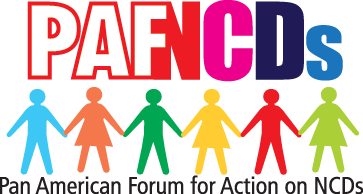 In December 2009, the Organization held a special Partners’ Forum against Non-communicable Diseases,¹ attended by representatives of civil society organizations, member governments, and the private sector.The initiative was re-launched in 2012 as the new Pan American Forum for Action on Non-communicable Diseases. It brings health professionals who are members of the Collaborative Action for Risk Factor Prevention and Effective Management of NCDs (CARMEN) network together with representatives of academic institutions and the private sector, with the goal of advancing strategic cross-sector collaboration and innovation to generate policies and campaigns for the prevention and control of chronic diseases.
In December 2009, the Organization held a special Partners’ Forum against Non-communicable Diseases,¹ attended by representatives of civil society organizations, member governments, and the private sector.The initiative was re-launched in 2012 as the new Pan American Forum for Action on Non-communicable Diseases. It brings health professionals who are members of the Collaborative Action for Risk Factor Prevention and Effective Management of NCDs (CARMEN) network together with representatives of academic institutions and the private sector, with the goal of advancing strategic cross-sector collaboration and innovation to generate policies and campaigns for the prevention and control of chronic diseases.
 A partnership with the World Economic Forum led in September 2011 to the first Wellness Week in New York City, on the eve of the United Nations High-Level Meeting on Non-communicable Diseases. Originally inspired by Caribbean Wellness Day (celebrated every September 13 in the Caribbean),Wellness Week 2011 sought to raise awareness of the importance of healthy settings in reducing risk factors for noncommunicable diseases and in promoting prevention.In New York, other partners included the Greater Harlem Chamber of Commerce, the New York Academy of Medicine, and the City College of New York. The week was also celebrated in other countries, including Argentina, Costa Rica, Cuba, Ecuador, El Salvador, Nicaragua, Peru, and Spain.
A partnership with the World Economic Forum led in September 2011 to the first Wellness Week in New York City, on the eve of the United Nations High-Level Meeting on Non-communicable Diseases. Originally inspired by Caribbean Wellness Day (celebrated every September 13 in the Caribbean),Wellness Week 2011 sought to raise awareness of the importance of healthy settings in reducing risk factors for noncommunicable diseases and in promoting prevention.In New York, other partners included the Greater Harlem Chamber of Commerce, the New York Academy of Medicine, and the City College of New York. The week was also celebrated in other countries, including Argentina, Costa Rica, Cuba, Ecuador, El Salvador, Nicaragua, Peru, and Spain.
¹Members and supporters include the World Economic Forum, the International Business Leaders Forum, the Inter-American Heart Foundation, Consumers International Latin American branch, 5-a-Day, the Healthy Caribbean Coalition, McGill University, the World Diabetes Foundation, the Public Health Agency of Canada, CDC, AECID, Kraft Foods, Unilever, Nestlé, Pepsi-Cola, Grupo Bimbo, Coca-Cola, Pfizer, GSK, Merck, Medtronic, Sanofi, and Johnson & Johnson.
PAHO Priority Countries
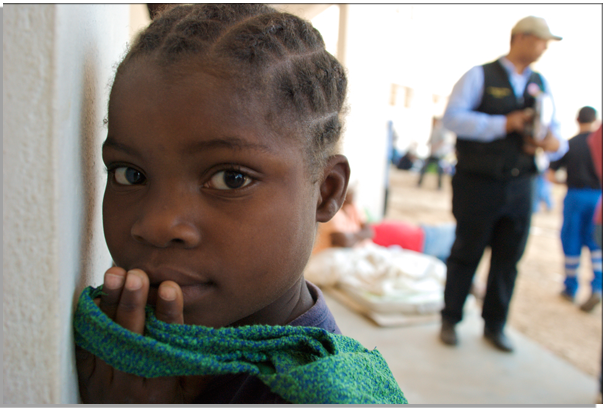 Five countries—Bolivia, Guyana, Haiti, Honduras, and Nicaragua—were identified in PAHO’s 2003-2007 and 2008-2012 strategic plans as “key countries” that faced health and equity challenges requiring special consideration in technical cooperation programs and resource mobilization. These five key countries have received higher allocations from the PAHO budget as well as priority consideration for inclusion into major grants and proposals that address their respective health needs. Four of the five key countries were among the first to have a Country Cooperation Strategy (CCS), a tool of PAHO’s Country Focus Policy that seeks to strengthen relations with the country’s Ministry of Health, align technical cooperation priorities with national needs, and coordinate efforts with other development partners working in these countries. (In the case of Haiti, political and emergency conditions made it necessary to adopt an Interim Cooperation Framework instead of the more comprehensive CCS.)
Five countries—Bolivia, Guyana, Haiti, Honduras, and Nicaragua—were identified in PAHO’s 2003-2007 and 2008-2012 strategic plans as “key countries” that faced health and equity challenges requiring special consideration in technical cooperation programs and resource mobilization. These five key countries have received higher allocations from the PAHO budget as well as priority consideration for inclusion into major grants and proposals that address their respective health needs. Four of the five key countries were among the first to have a Country Cooperation Strategy (CCS), a tool of PAHO’s Country Focus Policy that seeks to strengthen relations with the country’s Ministry of Health, align technical cooperation priorities with national needs, and coordinate efforts with other development partners working in these countries. (In the case of Haiti, political and emergency conditions made it necessary to adopt an Interim Cooperation Framework instead of the more comprehensive CCS.)
Highlights of recent PAHO/WHO technical cooperation and achievements in the five key countries include:
In Bolivia:
- (a) Support for the development of a new law to establish a Unified Health System as well as a new model for Family and Intercultural Health Care (SAFCI) that incorporates gender, ethnicity, and human rights.
- (b) Establishment of social protection measures for vulnerable groups, including women of childbearing age (SUMI) and seniors (SSPAM), which are being adjusted for inclusion into the Unified Health System, with universal coverage as the ultimate goal.
- (c) Implementation of community surveillance models in both urban and rural areas to reduce maternal mortality, with a focus on community involvement and empowerment as part of SAFCI. In addition, strengthening of the maternal and perinatal health records and information system. This includes the use of geo-referential software and databases by the Ministry of Health to analyze health services network functionality to provide evidence for changes or adjustments.
- (d) The development and implementation of a new national policy on human resources in health (HRH), strengthening of the HRH information system, and training on management and use of the SAFCI model.
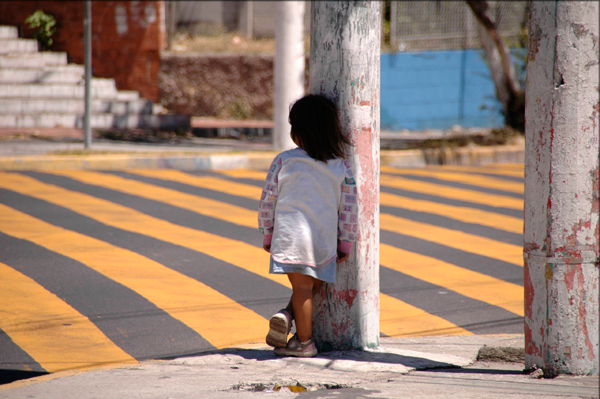 (e) Consolidation of a unified medicine and medical supplies acquisition and supply system, based on updated information in 81% of public health care systems. Implementation of a strategy on the rational use of medicines, with measures to promote efficiency, transparency, and accountability.
(e) Consolidation of a unified medicine and medical supplies acquisition and supply system, based on updated information in 81% of public health care systems. Implementation of a strategy on the rational use of medicines, with measures to promote efficiency, transparency, and accountability.- (f) Introduction of new vaccines—rotavirus (in partnership with GAVI), seasonal influenza, H1N1, and DPT boosters and polio boosters—into the National Immunization Plan; implementation of diverse strategies to maintain vaccine coverage rates; and progress toward certification of the country as being free of measles and rubella.
- (g) Massive deworming campaigns in endemic areas of La Paz for almost 400,000 inhabitants.
- (h) Development of the first national plan on noncommunicable diseases and integration of its variables into the national health information system.
In Guyana:
- (a) In-service training for health personnel in emergency obstetric and neonatal care, in collaboration with the U.N. Population Fund (UNFPA) and the U.N. Children’s Fund (UNICEF).
- (b) Development of a strategic plan for the sanitation sector.
- (c) Reductions in adult HIV prevalence over the last five years.
- (d) Strengthened primary health care through the expansion of the Integrated Management of Adolescent and Adult Illness (IMAI) program, under the Disease Control Program of the Ministry of Health. This program was recognized when Guyana won the Sergio Arouca Award in 2011.
- (e) A 50% reduction in malaria cases between 2000 and 2009 as a result of efforts including the decentralization and integration of the Malaria Information System into primary health care services (with support from the Amazon Malaria Initiative, the Amazon Network for Surveillance of Anti-malarial Drug Resistance, and PAHO) and the adoption of an integrated vector control management strategy, including the establishment of a vector control network.
- (f) Implementation of a patient monitoring system for HIV care and treatment, which has been documented as a best practice.
- (g) Introduction of rotavirus and pneumococcal vaccines (in partnership with GAVI).
In Haiti:
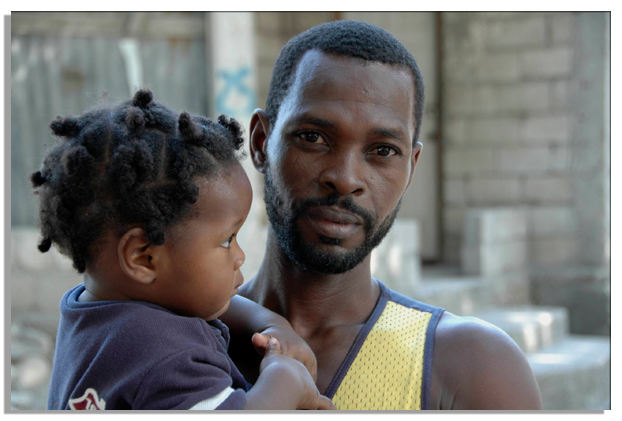 (a) Training in case management and strengthening of surveillance during the cholera outbreak.
(a) Training in case management and strengthening of surveillance during the cholera outbreak.- (b) The development and expansion of Free Obstetric Care (SOG) and Free Child Care (SIG), which offers free access to health services for children under 5.
- (c) Implementation of the first Perinatal Information System in real time, which will facilitate evidence-based decision making.
- (d) Reinitiation of the national childhood immunization program through the development of the Strategic Plan of the Expanded Program on Immunization for 2010-2015. (This was in addition to the post-disaster vaccination campaign conducted in the departments and municipalities most affected by the earthquake.)
- (e) Development of a national protocol for the treatment of acute malnutrition and its adaption to the post-disaster situation.
In Honduras:
- (a) A strategy to accelerate reductions in maternal and child mortality, including the institutionalization of the Perinatal Information System.
- (b) The introduction of new vaccines for rotavirus and pneumococcus (in partnership with GAVI).
- (c) Strengthening of epidemiological surveillance and a database (SISLOC) that has substantially improved surveillance of communicable diseases.
- (d) A national strategic plan for the control and prevention of cancer for 2009-2013.
- (e) A strategic plan for the prevention, care, control, and elimination of neglected diseases for 2012-2015.
- (f) A country-wide evaluation that certified the interruption of Chagas disease transmitted by Rhodnius prolixus.
- (g) Development of an integral malaria intervention model in the municipality of Wampusirpi. The project was selected as one of the Malaria Champions of the Americas for 2011.
- (h) Progress in addressing the determinants of health, with policy development in drinking water, sanitation, and waste management, and strengthening of legal and institutional frameworks that facilitate timely intervention.
- (i) As part of a Faces, Voices, and Places initiative, strengthening of health services for adolescents and improvement of water quality and waste management for the Misquito population in the department of Gracias a Dios.
- (j) With the support of the Secretary of State for Development of Indigenous Peoples and Afro-Hondurans, training of nursing assistants selected by communities.
In Nicaragua:
- (a) A 26% reduction in maternal mortality between 2006 and 2010, from 90 to 67 deaths per 100,000 live births.
- (b) Annual declines of 6% in under-5 mortality in recent years, putting the country on track to reach its goal of 24 per 1,000 live births by 2015.
- (c) Introduction of the rotavirus vaccine in 2006 and pneumococcal vaccine in 2011 (in partnership with GAVI).
- (d) An increase in the percentage of municipalities with over 95% vaccination coverage, from 16% in 2006 to 58% in 2011.
- (e) Reduced prevalence of mother-to-child transmission of HIV and syphilis.
- (f) Guaranteed universal access to free, quality health services within the framework of the Family and Community Care Model (MOSAFC), which encourages a national culture of health promotion and protection based on renewed primary health care.
- (g) Improved access to medicines, with a focus on quality and rational, effective, and safe use, through the implementation of the National Strategic Plan for the Promotion of Rational Use of Medicines (PENPURM).
- (h) Achievement of 100% voluntary blood donation in the national blood supply.
- (i) Progress in malaria control that earned recognition by the 2011 Malaria Champions of the Americas awards and that has advanced Nicaragua into the pre-elimination phase.
- (j) International certification of the country as having interrupted vertical transmission of Chagas disease.
Partnering for Health
Given the growing number of health actors in the Region over the past decade, an important focus for PAHO/WHO was expanding its political, technical, and resource mobilization partnerships and networks. Bilateral partners including Canada (CIDA), Norway (NORAD), Spain (AECID), Sweden (SIDA), and the United States (USAID) all continued to support the Organization’s technical cooperation programs through multiyear agreements. In addition, Canada, France, and Spain augmented PAHO/WHO’s technical staff by seconding their own experts to Headquarters in Washington, D.C., as well as to several PAHO/WHO Representative Offices in the countries.
PAHO/WHO served as an implementing agency for projects in Latin America and the Caribbean supported by the MDG Achievement Fund (Spain), the U.N. Trust Fund for Human Security (Japan), the U.N. Trust Fund to Eliminate Violence against Women (multi-donor), and the Rural Development Joint Program in Guatemala (Sweden). PAHO also supported health authorities and NGOs in developing and implementing projects submitted to the Global Fund to Fight AIDS, Tuberculosis, and Malaria.
Initiatives resulting from these partnerships included, among others, projects to improve drinking water, sanitation, and housing in Ecuador, El Salvador, Nicaragua, and the Chaco region of Paraguay, financed through the MDG Achievement Fund and carried out in partnership with other U.N. agencies. Joint projects in Ecuador, El Salvador, Guatemala, Nicaragua, and Paraguay focused on prevention of violence, particularly intra-family and gender-based violence, and improved treatment of victims by health services and law enforcement.
Partnerships for Sexual and Reproductive Health
A key area for PAHO/WHO’s collaboration with other international partners during the first decade of the 2000s was the promotion of a comprehensive approach to sexual and reproductive health, including access to family planning and contraception, improved obstetric care, and attention to vulnerable groups such as adolescents, sex workers, and people with HIV. Among the many activities and alliances in this area were:
|
 Other partnerships with U.N. sister agencies, international professional associations, faith-based organizations, and other civil society organizations were essential to PAHO/WHO’s work and to the Region’s public health achievements during the decade. These included the GTR, the Newborn Health Alliance for Latin America and the Caribbean³, the Safe Motherhood Initiative4, and the Pan American Alliance for Nutrition and Development (PAND).5 Other organizations with which the Organization worked closely included the GAVI Alliance, the Sabin Vaccine Institute, Rotary International and the Rotary Foundation, the United Nations Foundation, the Council of the Americas, Save the Children, Enfants du Monde, the Latin American Episcopal Conference (CELAM), the Church of Jesus Christ of Latter-day Saints, the General Conference of Seventh-day Adventists, Brothers of Charity, Partners in Health, RAD-AID International, and the American, Canadian, and international Red Cross organizations, among others.
Other partnerships with U.N. sister agencies, international professional associations, faith-based organizations, and other civil society organizations were essential to PAHO/WHO’s work and to the Region’s public health achievements during the decade. These included the GTR, the Newborn Health Alliance for Latin America and the Caribbean³, the Safe Motherhood Initiative4, and the Pan American Alliance for Nutrition and Development (PAND).5 Other organizations with which the Organization worked closely included the GAVI Alliance, the Sabin Vaccine Institute, Rotary International and the Rotary Foundation, the United Nations Foundation, the Council of the Americas, Save the Children, Enfants du Monde, the Latin American Episcopal Conference (CELAM), the Church of Jesus Christ of Latter-day Saints, the General Conference of Seventh-day Adventists, Brothers of Charity, Partners in Health, RAD-AID International, and the American, Canadian, and international Red Cross organizations, among others. In the private sector, PAHO worked with organizations and programs including the International Business Leaders Forum (IBLF), the Global Business Forum (GBF), the Pfizer Global Health Fellows, the GSK Pulse Program, the Oral Health Partnership (with Colgate), and the International Federation of Pharmaceutical Manufacturers & Associations (IFPMA).
As a member of the inter-American system, PAHO/WHO advocated for public health issues on the regional political agenda through its participation in the Summit of the Americas Working Group, meetings of the Summit Implementation Review Group (SIRG), and briefing sessions for the Permanent Council of the Organization of American States (OAS). Along with the World Bank and the Inter-American Development Bank (IDB), the Organization also participated in the OAS-led Friends of Haiti group, a forum for information exchange and coordination of political and technical support by countries and organizations involved in Haiti.
PAHO/WHO also participated in U.N. reform efforts with other U.N. agencies through the U.N. Country Teams (UNCTs) and the Common Country Assessment/U.N. Development Assistance Framework (CCA/UNDAF), as well as thought its membership in the regional U.N. Development Group for Latin America and the Caribbean (UNDG-LAC).
At the subregional level, the Organization continued partnering with traditional regional integration bodies while also working with new entities. These partnerships led to a number of new subregional health initiatives. In South America and the Andean region, PAHO’s collaboration led to country-to-country cooperation on HIV surveillance in MERCOSUR border areas, a collective framework for assessing health technologies, the development of pharmaceutical services in countries of the Andean community, a comprehensive five-year work plan to promote access to medicines within UNASUR, and the creation of an Andean Network of Observatories of Human Resources in Health. In addition, PAHO collaborated with the Amazon Cooperation Treaty Organization (OTCA) to advance the health goals of its Strategic Agenda.
In Central America and the Dominican Republic, PAHO coordination led to the development of a strategic subregional plan to reduce vertical transmission of HIV and congenital syphilis, agreements with COMISCA (Council of Ministers of Health) and COMMCA (Council of Ministers of Women’s Affairs) on multisectoral health action, pooled procurement of vaccines and other medicines, and the formation of subregional technical commissions on essential medicines, human resources for health, noncommunicable diseases, health surveillance, and information systems.
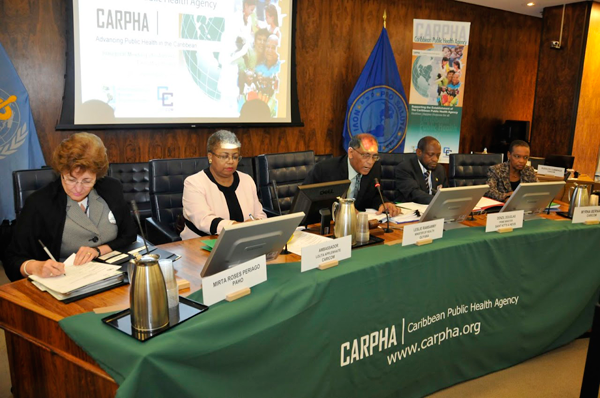 In the Caribbean, PAHO/WHO collaborated with the new Caribbean Public Health Agency (CARPHA) and CARICOM’s Council for Human and Social Development (COHSOD) in the areas of chronic diseases, health promotion, adolescent health, and crime prevention, among others. This included support for the integration of nutrition and health into agricultural and food safety policies, in follow-up to the Port-of-Spain Declaration and the U.N. High-Level Meeting on NCDs. Other efforts helped improve disease surveillance, strengthen laboratories (including in the use of polymerase chain reaction), and create a new framework for laboratory accreditation by PAHO’s Caribbean Epidemiology Center (CAREC).
In the Caribbean, PAHO/WHO collaborated with the new Caribbean Public Health Agency (CARPHA) and CARICOM’s Council for Human and Social Development (COHSOD) in the areas of chronic diseases, health promotion, adolescent health, and crime prevention, among others. This included support for the integration of nutrition and health into agricultural and food safety policies, in follow-up to the Port-of-Spain Declaration and the U.N. High-Level Meeting on NCDs. Other efforts helped improve disease surveillance, strengthen laboratories (including in the use of polymerase chain reaction), and create a new framework for laboratory accreditation by PAHO’s Caribbean Epidemiology Center (CAREC). These subregional activities were supported by a special allocation in the Organization’s program budget, as was the work of the Caribbean Food and Nutrition Center (CFNI), and the Office of Caribbean Program Coordination (CPC).
In June 2012, PAHO/WHO launched the Regional Coalition for Water and Sanitation to Eliminate Cholera from the Island of Hispaniola, which seeks to mobilize financial resources, technical expertise, and political commitment to ensure investments in water and sanitation infrastructure that are needed to eventually eliminate cholera from Haiti and the Dominican Republic. In addition to PAHO/WHO, initial members of the coalition include the OAS, the U.S. Centers for Disease Control and Prevention (CDC), UNICEF, AECID, the Inter-American Association of Environmental Health Engineers (AIDIS), the IDB, the National Health Foundation of Brazil (FUNASA), USAID, and the Haitian Association of Medical Physicians Abroad.
All these partnerships were in addition to PAHO/WHO’s ongoing collaboration at the country level with professional, academic, charitable, faith-based, and other civil society organizations and its coordination with national, departmental, and local authorities from sectors including health, education, agriculture, development, environment, and women’s and indigenous affairs.
²Members include PAHO/WHO, UNICEF, UNFPA, USAID, the World Bank, the IDB, the Population Council, Family Care International (FCI), the Latin American Federation of Societies of Obstetrics and Gynecology (FLASOG), the Pan-American Federation of Nursing Professionals (FEPPEN), and the International Confederation of Midwives (ICM).
³Members include PAHO/WHO, UNICEF, USAID, ACCESS, BASICS, CORE Group, Plan USA, University Research Co./Center for Human Services (URC/CHS), Save the Children/Saving Newborn Lives, the Latin American Association of Pediatrics (ALAPE), ICM, and FLASOG.
4Members include the members of the GTR as well as the OAS and the La Caixa Foundation of Spain.
5Members include PAHO/WHO, UNDP, UNICEF, ECLAC, UNFPA,ILO, WFP, UNDOC, UNAIDS, UN Women, and UNOPS.
Promoting Public Health Networks
 In its capacity as a catalyst for regional and subregional collaboration in public health, PAHO/WHO helped to create or expand networks linking people and institutions to share knowledge and mobilize expertise, resources, and action toward common goals. Some of these networks sponsor periodic meetings or workshops for members, while others are virtual networks that take advantage of the opportunities presented by growing access to the Internet and other information technologies throughout the Region. Examples of these physical and virtual networks include:
In its capacity as a catalyst for regional and subregional collaboration in public health, PAHO/WHO helped to create or expand networks linking people and institutions to share knowledge and mobilize expertise, resources, and action toward common goals. Some of these networks sponsor periodic meetings or workshops for members, while others are virtual networks that take advantage of the opportunities presented by growing access to the Internet and other information technologies throughout the Region. Examples of these physical and virtual networks include:
- (a) The Collaborative Network for Primary Health Care, formed in partnership with the Ministry of Health of Brazil and the School of Public Health of Andalusia (Spain) to promote exchange of knowledge and best practices based on the PHC approach.
- (b) The Regional Network of Pharmaceutical Procurement and Supply Management Authorities (CARIPROSUM), created with the participation of national procurement authorities of Caribbean countries to promote the continuous availability of safe, effective, and affordable pharmaceutical products for the public health sector.
- (c) The Regional Network for Health Technology Assessment, which will help Member States access and analyze evidence to determine the comparative value-added of new medicines, medical products, and health interventions within health systems.
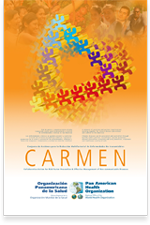 (d) CARMEN (Collaborative Action for Risk Factor Prevention and Effective Management of NCDs), a network of countries, organizations, and institutions working to reduce the burden of chronic diseases and their risk factors in the Americas.
(d) CARMEN (Collaborative Action for Risk Factor Prevention and Effective Management of NCDs), a network of countries, organizations, and institutions working to reduce the burden of chronic diseases and their risk factors in the Americas. - (e) Health Research Web/Americas, created with the Council on Health Research for Development (COHRED), to help countries and individuals establish policies and priorities for health research, increase the relevance of research, and improve skills for research by providing information resources and facilitating country-to-country exchanges.
- (f) Red Salud (“Health Network”), which links 2,500 health journalists and was created in partnership with the Communication Initiative and the Iberoamerican New Journalism Foundation to help improve media coverage of public health issues.
- (g) The Americas’ Network for Chronic Disease Surveillance (AMNET), also supported by the U.S. Centers for Disease Control and Prevention (CDC) and Environmental Protection Agency (EPA), Health Canada, the Ministry of Health of Finland, and the ministries of health of other PAHO member countries.
- (h) The Water Safety Plan Network for Latin America and the Caribbean (WSP/LAC NETWORK), formed in partnership with the U.S. CDC and EPA to support and promote the implementation of water safety plans in cities in Latin America and the Caribbean. The Inter-American Sanitary and Environmental Engineering Association (AIDIS), the International Water Association (IWA), and UN-HABITAT are also members.
- (i) The Amazon Network for the Surveillance of Antimalarial Drug Resistance (RAVREDA), organized with Bolivia, Brazil, Colombia, Ecuador, Guyana, Peru, Suriname, and Venezuela to monitor antimalarial drug resistance in the Amazon.
- (j) The Amazon Malaria Initiative (AMI), created in partnership with USAID and supported by the CDC, Management Sciences for Health, and United States Pharmacopeia.
- (k) The BiVaPad network, a joint effort with the Andean Community, the Regional Disaster Information Center for Latin America and the Caribbean, the International Strategy for Disaster Reduction, and partner organizations of the Andean Committee for Disaster Prevention and Relief (CAPRADE) to facilitate information-sharing on risk management and mitigation of emergencies and disasters.
- (l) The Inter-American Coalition for Violence Prevention, organized in partnership with the OAS, other U.N. agencies, USAID, and the CDC.
 The Organization’s most far-reaching effort to capitalize on expanding Internet access was the Virtual Campus for Public Health, a networked learning initiative that links individuals and organizations to share information, knowledge, and educational opportunities in public health. Since 2003, the Virtual Campus has grown from a pilot project with 13 partner institutions to a network of 144 institutions in 11 countries. In the past five years, more than 5,300 users have benefitted from over 150 courses offered by the network, and its interoperability with BIREME’s Virtual Health Library provides virtual access to some 3,600 additional educational resources. The Virtual Campus is supported by the governments of Canada, Cuba, and Spain and is part of PAHO/WHO’s efforts to strengthen human resources for health.
The Organization’s most far-reaching effort to capitalize on expanding Internet access was the Virtual Campus for Public Health, a networked learning initiative that links individuals and organizations to share information, knowledge, and educational opportunities in public health. Since 2003, the Virtual Campus has grown from a pilot project with 13 partner institutions to a network of 144 institutions in 11 countries. In the past five years, more than 5,300 users have benefitted from over 150 courses offered by the network, and its interoperability with BIREME’s Virtual Health Library provides virtual access to some 3,600 additional educational resources. The Virtual Campus is supported by the governments of Canada, Cuba, and Spain and is part of PAHO/WHO’s efforts to strengthen human resources for health.One of the Organization’s newest networking initiatives is the Regional Platform on Access and Innovation for Health Technologies (PRAIS), launched in 2012 with support from Brazil and the U.S. Food and Drug Administration (FDA). Part of efforts to promote access to essential medicines and technologies, the initiative links networks, information resources, and communities of practice to promote technology transfer and to improve capacity and governance in the pharmaceutical development sector.
A similar virtual networking initiative, the Cooperation among Countries for Health Development portal on the PAHO website, promotes South-South knowledge-sharing, cooperation, and partnerships.
The Organization’s commitment to seizing the opportunities presented by new information and communication technologies (ICT) led to the development of a new Strategy and Plan of Action on eHealth, approved by the 51st Directing Council in 2011 (CD/51.R5). It seeks to use ICT tools and methodologies to improve public and veterinary health in such areas as health administration, human resources, coordination and delivery of health services, and the production and dissemination of scientific and technical knowledge.
Practical applications of ICTs in health that are highlighted in the eHealth strategy include personal health cards, digital clinical histories, electronic prescriptions, online appointments, telemedicine, distance learning and continuing education, health blogs and portals, call centers, databases for risk management and patient safety, social networking tools for disasters and emergencies, and the digitalization of clinical and administrative documentation. Potential users include health workers, patients, and the public in general.
Promoting Preparedness
 The first decade of the 21st century brought a series of emergencies and disasters to the Region of the Americas. Unlike in much of the previous century, however, most of the Region’s countries today have the capacity to respond to minor or even moderate events without international assistance. PAHO/WHO has played a role in this progress through its work with ministries of health to establish and strengthen disaster and emergency response programs and to develop regional strategies for reducing the health impact of disasters.
The first decade of the 21st century brought a series of emergencies and disasters to the Region of the Americas. Unlike in much of the previous century, however, most of the Region’s countries today have the capacity to respond to minor or even moderate events without international assistance. PAHO/WHO has played a role in this progress through its work with ministries of health to establish and strengthen disaster and emergency response programs and to develop regional strategies for reducing the health impact of disasters.
Levels of preparedness vary widely across countries, however, and the severity of hazardous events in some cases has far exceeded countries’ capacities to respond. The most tragic recent case was the 2010 earthquake in Haiti, which claimed more than 200,000 lives and affected most of the Haitian population. As in most disasters, Haitians themselves saved hundreds of lives and attended to thousands of injured and homeless, with support from their closest neighbors starting with the Dominican Republic and followed by Cuba and other Caribbean countries. However, the support of the broader international community was also crucial for the longer-term response and recovery.
PAHO/WHO played a critical role in these efforts as head of the Health Cluster, which provided coordination for hundreds of organizations working in health, and as co-administrator with the Haitian 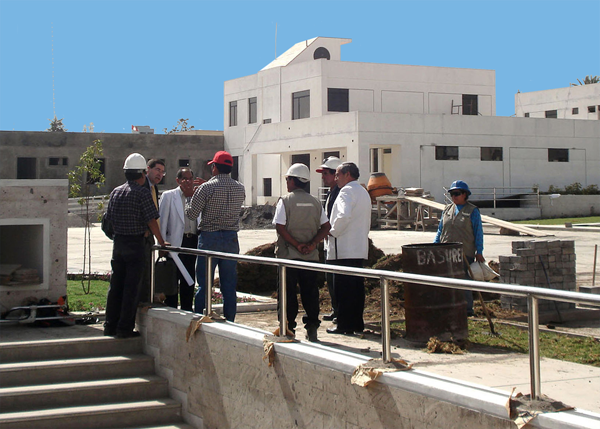 government of the national pharmaceutical warehouse, PROMESS. The Organization also oversaw quality control of drinking water at chlorination sites, helped restore operations at the National Public Health Laboratory, and helped develop a database and maps ofthe locations of existing health facilities and health partners working in the country. (This support is described in greater detail in the Annual Report of the Director 2010: Promoting Health, Well-being, and Human Security in the Americas.)
government of the national pharmaceutical warehouse, PROMESS. The Organization also oversaw quality control of drinking water at chlorination sites, helped restore operations at the National Public Health Laboratory, and helped develop a database and maps ofthe locations of existing health facilities and health partners working in the country. (This support is described in greater detail in the Annual Report of the Director 2010: Promoting Health, Well-being, and Human Security in the Americas.)
Health partnerships that were strengthened following Haiti’s January 2010 earthquake were again critical for the response to the cholera epidemic that began in October of the same year. The response was complicated by continuing weaknesses in the country’s health system and the fact that health workers had little or no experience with a disease that had not been seen in Haiti in more than a century. PAHO/WHO and other partners helped health authorities establish cholera treatment centers and mobilized resources and expertise in areas including case management, provision of essential medicines and supplies, disease surveillance and early warning, training and guidelines, prevention messages, and environmental health.
The 2009 H1N1 Influenza Pandemic
The first influenza pandemic of the new millennium began in the Americas and spread throughout the world within months. While it was considerably less severe than initially feared, it claimed thousands of lives and revealed important weaknesses in countries’ health systems. The large numbers of cases, coupled with people’s uncertainty about the virulence of the virus, put a strain on hospitals and health facilities in a number of countries, and some governments responded by adopted ineffective and unnecessary restrictions on people’s movements. This highlighted the need for greater investments in public health in general, and for strengthening primary health care in particular, as well as the importance of evidence-based public policy.The 2009 H1N1 influenza pandemic also served as a test for preparedness efforts that PAHO/WHO had promoted in the Region following the 2003 SARS outbreak and concerns about the growing threat of H5N1 influenza. A review meeting by Member State representatives in late 2009 concluded that these efforts had paid off, but that most
 countries’ pandemic preparedness plans had been insufficiently operational, particularly at the local level. The review called for better coordination with the private health sector as well as greater clarity about information flows and the resources needed for implementing enhanced surveillance.
countries’ pandemic preparedness plans had been insufficiently operational, particularly at the local level. The review called for better coordination with the private health sector as well as greater clarity about information flows and the resources needed for implementing enhanced surveillance. In addition to these preparedness efforts, PAHO/WHO played a key supporting role throughout the 2009 H1N1 influenza pandemic, which had a significant impact on the entire Region (see also Chapter I). Immediately following Mexico’s notification of the outbreak, PAHO/WHO activated its Emergency Operations Center and through the WHO Global Outbreak Alert and Response Network (GOARN) began mobilizing international experts in epidemiology, emergency management, laboratories, communication, health services, health promotion, and immunization, among others. As the epidemic spread, PAHO/WHO supported countries by coordinating the purchase of antivirals (oseltamivir), personal protective gear, and laboratory equipment and materials, and also provided training in the use of polymerase chain reaction to detect the pandemic virus. Once the pandemic vaccine became available, the PAHO Revolving Fund helped procure more than 20 million doses for 23 countries.
The pandemic also provided a test of the new International Health Regulations (IHR), which have been a major focus of PAHO/WHO technical cooperation in outbreak alert and response to help countries fully comply with the regulations. The 2009 regional pandemic review meeting concluded that IHR, through its national focal points, had proven to be an effective mechanism for alerting and informing Member States, had helped inform recommendations by health authorities, and had increased the latter’s credibility by promoting transparency. However, the pandemic had also revealed a lack of harmonization in countries’ surveillance systems and gaps in national legal frameworks that impede full compliance with IHR.
Back to top





